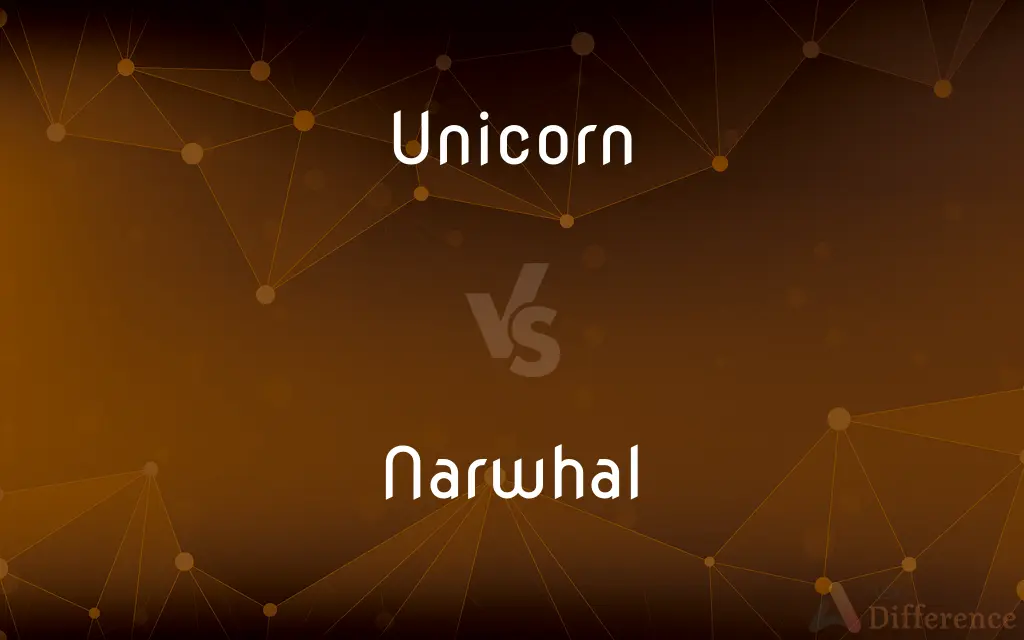Unicorn vs. Narwhal — What's the Difference?
By Fiza Rafique & Maham Liaqat — Updated on April 27, 2024
Unicorn is a mythical creature represented with a horse-like body and a single horn; narwhal is a real marine animal, known for its long, spiral tusk.

Difference Between Unicorn and Narwhal
Table of Contents
ADVERTISEMENT
Key Differences
The unicorn is a legendary figure in various mythologies, often depicted as a horse with a single, spiraling horn protruding from its forehead, symbolizing purity and grace. On the other hand, the narwhal is an actual marine mammal, existing in the Arctic waters, distinguished by its characteristic long, helical tusk, which is actually an elongated upper left canine tooth.
Unicorns have been a part of folklore and stories, typically representing magical or divine forces, commonly featured in Western narratives and medieval European tales. Narwhals, while sometimes called "the unicorns of the sea," are subjects of biological and environmental studies, crucial for understanding marine ecosystems and the impacts of climate change.
In cultural symbolism, unicorns are often associated with innocence, beauty, and rarity, commonly appearing in modern fantasy literature and children's stories. In contrast, narwhals are sometimes included in Inuit legends and are more associated with the rugged and mysterious nature of the Arctic.
Regarding habitat, unicorns, as mythical beings, are imagined to roam enchanted forests and mystical lands in tales and folklore. Whereas, narwhals are real creatures that navigate the cold, icy waters of the Arctic Circle, often traveling in groups known as pods.
In terms of conservation status, unicorns, being mythical, do not require protection or conservation efforts. Narwhals, however, are considered Near Threatened, with their populations affected by climate change, hunting, and habitat disturbance.
ADVERTISEMENT
Comparison Chart
Nature
Mythical creature
Real marine animal
Symbolism
Purity, grace, magic
Mystery of the Arctic
Cultural Role
Central in Western folklore
Featured in Inuit legends, scientific studies
Habitat
Imagined in enchanted forests
Arctic waters, ice-covered seas
Conservation Need
None (mythical)
Near Threatened (climate change impacts)
Compare with Definitions
Unicorn
Featured in fantasy literature.
Unicorns are prominent in many medieval and modern fantasies.
Narwhal
Travels in groups known as pods.
A pod of narwhals was spotted near the ice floe.
Unicorn
A mythical animal resembling a horse with a single horn.
She decorated her room with paintings of unicorns.
Narwhal
Called "the unicorn of the sea" due to its tusk.
Narwhals are sometimes mistaken for mythical creatures because of their impressive tusks.
Unicorn
Symbol of purity and grace in folklore.
The unicorn is often used to symbolize magic and purity.
Narwhal
Affected by environmental changes.
Narwhals are increasingly impacted by the melting Arctic ice.
Unicorn
Emblem of rarity and uniqueness.
His collection of classic cars is as rare as a unicorn.
Narwhal
A real Arctic mammal known for its spiral tusk.
The narwhal's tusk can grow up to ten feet long.
Unicorn
Associated with magical powers.
In the story, the unicorn had the power to purify water.
Narwhal
Subject of marine research and studies.
Scientists study narwhals to learn more about Arctic marine life.
Unicorn
The unicorn is a legendary creature that has been described since antiquity as a beast with a single large, pointed, spiraling horn projecting from its forehead. The unicorn was mentioned by the ancient Greeks in accounts of natural history by various writers, including Ctesias, Strabo, Pliny the Younger, Aelian and Cosmas Indicopleustes.
Narwhal
The narwhal or narwhale (Monodon monoceros) is a medium-sized toothed whale that possesses a large "tusk" from a protruding canine tooth. It lives year-round in the Arctic waters around Greenland, Canada, and Russia.
Unicorn
A fabled creature symbolic of virginity and usually represented as a horse with a single straight spiral horn projecting from its forehead.
Narwhal
An Arctic whale (Monodon monoceros) having mottled gray or whitish skin and in the male, a long spirally twisted tusk projecting forward from the left side of the head.
Unicorn
(Heraldry) A representation of this beast, having a horse's body, a stag's legs, a lion's tail, and a straight spiral horn growing from its forehead, especially employed as a supporter for the Royal Arms of Great Britain or of Scotland.
Narwhal
Monodon monoceros, an Arctic cetacean that grows to about 20 feet (6 meters) long, the male having a single horn-like tusk, a twisted, pointed canine tooth that projects forward.
Unicorn
Unicorn The constellation Monoceros.
Narwhal
An arctic cetacean (Monodon monocerous), about twenty feet long. The male usually has one long, twisted, pointed canine tooth, or tusk, projecting forward from the upper jaw like a horn, whence it is called also sea unicorn, unicorn fish, and unicorn whale. Sometimes two horns are developed, side by side.
Unicorn
Something that is greatly desired but difficult or impossible to find
“Is antigravity the unicorn of physics? Or do we simply lack the strategy and bait to catch it in an experimental snare?” (Jerome Groopman).
Narwhal
Small arctic whale the male having a long spiral ivory tusk
Unicorn
(Business) A startup company valued at one billion dollars or more.
Unicorn
A mythical beast resembling a horse or deer with a single, straight, spiraled horn projecting from its forehead.
Unicorn
(historical) In various Bible translations, used to render the Latin rhinoceros (representing Hebrew ):}} a reem or wild ox.
Unicorn
Any large beetle having a horn-like prominence on the head or prothorax, especially the Hercules beetle, Dynastes tityus.
Unicorn
A caterpillar, Schizura unicornis, with a large thorn-like spine on the back near its head.
Unicorn
The kamichi, or unicorn bird.
Unicorn
(military) A howitzer.
Unicorn
Someone or something that is rare and hard to find.
Unicorn
A single, usually bisexual woman who participates in swinging or polyamory.
Unicorn
(business) A person with multidisciplinary expertise, especially three or more skills in a young field such as UX design or data science (e.g., domain knowledge, statistics, and software engineering).
Purple squirrel
Unicorn
(finance) A startup company whose valuation has exceeded one billion U.S. dollars, which is solely backed by venture capitalists, and which has yet to have an IPO.
Unicorn
(attributive) Being many (especially pastel) colours; multicoloured.
Unicorn smoothies
Unicorn
(historical) A 15th-century Scottish gold coin worth 18 shillings, bearing the image of a unicorn.
Unicorn
(sexual slang) To participate in a sexual threesome as a bisexual addition to an established heterosexual couple.
Unicorn
(finance) To exceed a valuation of one billion U.S. dollars, while solely backed by venture capitalists.
Unicorn
Having one horn.
Unicorn
A fabulous animal with one horn; the monoceros; - often represented in heraldry as a supporter.
Unicorn
A two-horned animal of some unknown kind, so called in the Authorized Version of the Scriptures.
Canst thou bind the unicorn with his band in the furrow?
Unicorn
Any large beetle having a hornlike prominence on the head or prothorax.
Unicorn
The kamichi; - called also unicorn bird.
Unicorn
A howitzer.
Unicorn
An imaginary creature represented as a white horse with a long horn growing from its forehead
Common Curiosities
Do narwhals use their tusks for fighting?
Narwhals primarily use their tusks for sensory purposes and social interactions, not typically for fighting.
What is the main difference between a unicorn and a narwhal?
Unicorns are mythical creatures with horse-like bodies and a horn, while narwhals are real marine mammals with a long tusk.
Are narwhals endangered?
Narwhals are classified as Near Threatened, mainly due to environmental changes and human activities.
Can unicorns and narwhals be found in the same habitats?
No, unicorns are imaginary and typically placed in mystical lands, whereas narwhals live in the Arctic marine environments.
Why are unicorns so popular in children’s stories?
Unicorns appeal to children due to their magical attributes, beauty, and the sense of wonder they inspire.
Has a unicorn ever been believed to be real?
In various historical periods, unicorns were believed to be real creatures, often depicted in ancient texts and art.
How do scientists study narwhals?
Scientists study narwhals through tracking their movements, studying their diet, and monitoring their responses to environmental changes.
What makes unicorns so distinctive in mythology?
Their singular horn and the magical powers attributed to them make unicorns distinctive and captivating in mythology.
How do environmental changes impact narwhals?
Climate change affects narwhals by altering their habitat, ice cover, and prey availability, which can influence their migration and breeding patterns.
What does the unicorn's horn symbolize?
The unicorn's horn traditionally symbolizes purity, grace, and great healing powers.
What are the physical characteristics of a narwhal?
Narwhals are characterized by their greyish body, distinctive long, spiral tusk, and they can grow up to 17 feet in length.
What role do narwhals play in Inuit culture?
Narwhals are significant in Inuit culture for their spiritual value and as a source of food and materials.
Is the unicorn considered a symbol in any modern contexts?
Yes, unicorns are often used symbolically in modern culture to represent uniqueness, rarity, and magical appeal.
Are there any recent discoveries related to narwhals?
Recent studies focus on how narwhals adapt to diminishing ice habitats and the effects of global warming on their behavior.
Share Your Discovery

Previous Comparison
Chimney vs. Stack
Next Comparison
Field vs. MeadowAuthor Spotlight
Written by
Fiza RafiqueFiza Rafique is a skilled content writer at AskDifference.com, where she meticulously refines and enhances written pieces. Drawing from her vast editorial expertise, Fiza ensures clarity, accuracy, and precision in every article. Passionate about language, she continually seeks to elevate the quality of content for readers worldwide.
Co-written by
Maham Liaqat















































